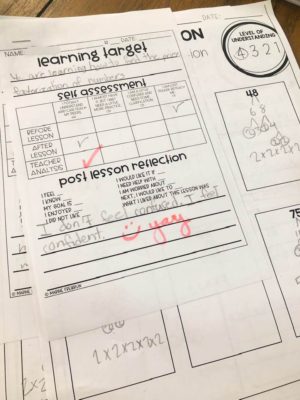
Part of Teacher Clarity is giving your students a clear understanding of the learning goals and your expectations. One way to do that is by using Target Responses.
A target response is a writing sample that shows your students exactly what they need to do in order to achieve mastery of the standard. It includes transitions, citations, grammar, and anything else you expect from your students in their writing.
It’s easy to develop a Target Response, just follow these steps:
Write the sample yourself.
Let’s say you have an upcoming writing standard you’re trying to tackle. Maybe it’s using the writing strategy R.A.C.E. or maybe it’s opinion writing. Look at your pacing guide and determine which upcoming writing purpose you’ll focus on for this target response. For the purpose of this example, I’ll use the R.A.C.E. strategy.
Once you’ve chosen the writing purpose, write out exactly what you want your students to accomplish. Write as if you were in that grade level, while also holding your students to high expectations. Here’s a sample of what I expect my third grade students to write when using R.A.C.E.:

Identify the language functions in the response.
Language functions are the purpose for which we use language to communicate:
- Compare/Contrast
- Opinion
- Describe
- Time Sequence
- Cause/Effect
In the target response I wrote, I have identified cause/effect language.

Identify grammar, transition words, and anything else you think you need to teach before having your students write.
Not only do you need to identify the language functions, but you should also make sure you identify any transition words, grammar skills, or other skills (like citing evidence). It’s important to identify this in your target response because it will help you plan out your lessons that lead up to the writing assignment.
Here are some examples I identified in my target response:

I’ll need to make sure my students are aware of citing evidence and using correct transition words. It would also be helpful to have some lessons on contractions and adjectives. We will also be using the R.A.C.E. writing strategy, so I’ll need to make sure to include a lesson for that as well.
Create sentence frames based on the target response.
Now I’ll take what I have identified and create sentence frames that I can give to my students as a guide. I used the language functions to create sentence/language frames for my students.

Plan with the end in mind.
I identified that my students will need to know cause/effect language, contractions, citing evidence, and the R.A.C.E. strategy. I will have at least four lessons before having my students write independently. Identifying which skills my students need to be successful before writing will help them tremendously. This target response can even be displayed for students as you start the series of lessons. Let them know that their end goal will be creating this writing assignment. Take the skills you identified and pace out your lessons so your students can meet the end learning goal.
Give your students all the support.
When it comes time, give your students all of the support. Let them use the sentence frames, let them see the target response you wrote, let them compare their writing to the target. You’ll see that students will be more eager to write and feel more confident.
The strategy for writing a target response can be used for any writing purpose. Think about what you want your students to write, and write it out. Identify skills they’ll need to have in order to meet the writing goal, then go back and plan with the end in mind. Finally, give your students the support to be successful in writing.
Integrating AI to Streamline Target Response Development
Incorporating artificial intelligence (AI) tools, such as ChatGPT, can significantly enhance the efficiency and effectiveness of creating target responses. Here’s how you can leverage AI in this process:
-
Generate Initial Exemplars: Input your writing prompt into ChatGPT to produce a sample response that meets your assignment’s criteria. This provides a foundational exemplar for students.
-
Identify Key Components: Analyze the AI-generated response to pinpoint language functions (e.g., compare/contrast, opinion), transition words, grammar structures, and other essential elements.
-
Develop Language Frames: Utilize insights from the exemplar to create sentence frames or starters, aiding students in structuring their writing effectively.
-
Design Differentiated Models: Request ChatGPT to generate responses at varying proficiency levels, offering students clear benchmarks for self-assessment and goal setting.
By integrating AI tools into your instructional design, you not only save valuable time but also provide diverse resources that cater to varying student needs, ultimately enhancing the writing instruction process.
To get more teaching ideas, subscribe here!
You can find a template for writing Target Responses in my book, Getting Started with Teacher Clarity.
Find my R.A.C.E. Direct Instruction lesson here.




